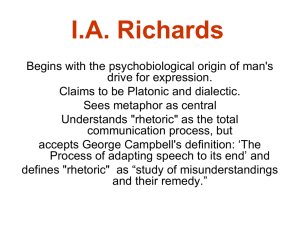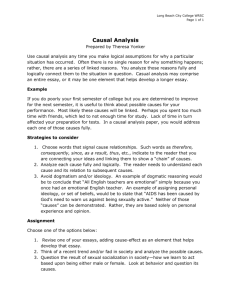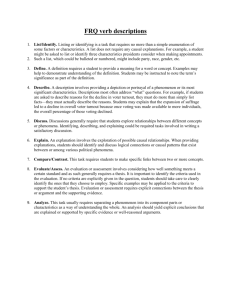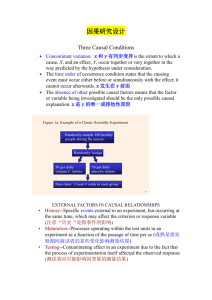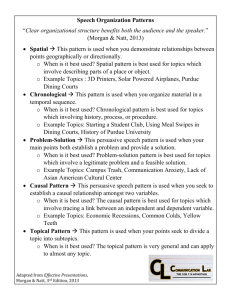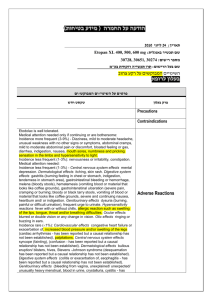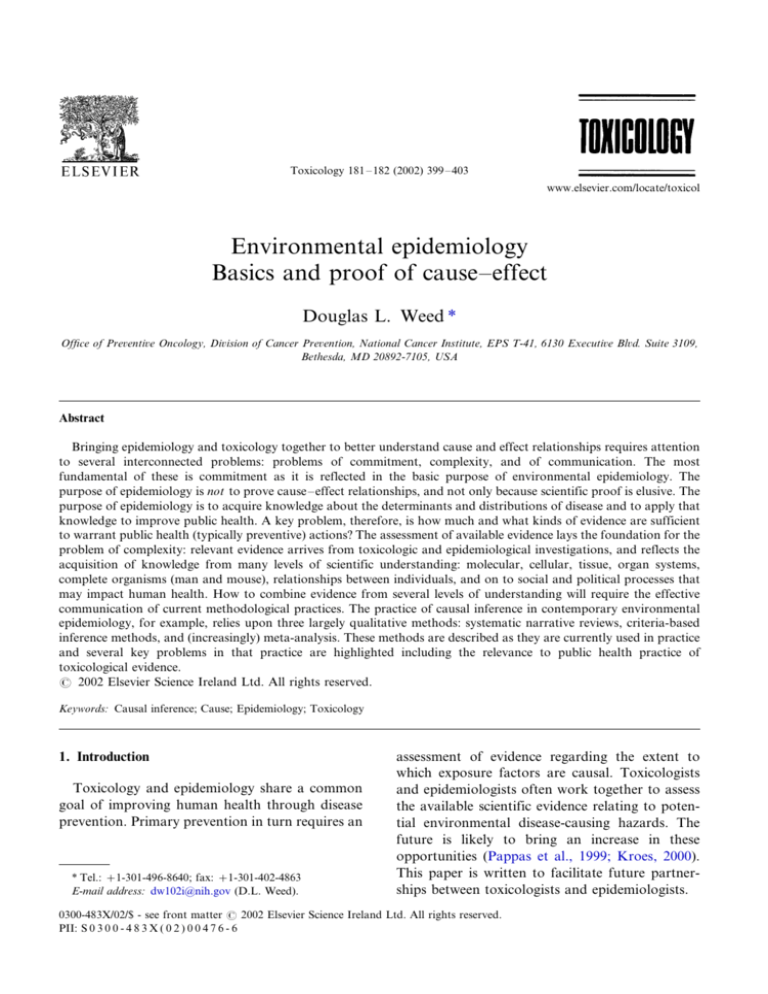
Toxicology 181 /182 (2002) 399 /403
www.elsevier.com/locate/toxicol
Environmental epidemiology
Basics and proof of cause effect
/
Douglas L. Weed Office of Preventive Oncology, Division of Cancer Prevention, National Cancer Institute, EPS T-41, 6130 Executive Blvd. Suite 3109,
Bethesda, MD 20892-7105, USA
Abstract
Bringing epidemiology and toxicology together to better understand cause and effect relationships requires attention
to several interconnected problems: problems of commitment, complexity, and of communication. The most
fundamental of these is commitment as it is reflected in the basic purpose of environmental epidemiology. The
purpose of epidemiology is not to prove cause /effect relationships, and not only because scientific proof is elusive. The
purpose of epidemiology is to acquire knowledge about the determinants and distributions of disease and to apply that
knowledge to improve public health. A key problem, therefore, is how much and what kinds of evidence are sufficient
to warrant public health (typically preventive) actions? The assessment of available evidence lays the foundation for the
problem of complexity: relevant evidence arrives from toxicologic and epidemiological investigations, and reflects the
acquisition of knowledge from many levels of scientific understanding: molecular, cellular, tissue, organ systems,
complete organisms (man and mouse), relationships between individuals, and on to social and political processes that
may impact human health. How to combine evidence from several levels of understanding will require the effective
communication of current methodological practices. The practice of causal inference in contemporary environmental
epidemiology, for example, relies upon three largely qualitative methods: systematic narrative reviews, criteria-based
inference methods, and (increasingly) meta-analysis. These methods are described as they are currently used in practice
and several key problems in that practice are highlighted including the relevance to public health practice of
toxicological evidence.
# 2002 Elsevier Science Ireland Ltd. All rights reserved.
Keywords: Causal inference; Cause; Epidemiology; Toxicology
1. Introduction
Toxicology and epidemiology share a common
goal of improving human health through disease
prevention. Primary prevention in turn requires an
Tel.: /1-301-496-8640; fax: /1-301-402-4863
E-mail address: dw102i@nih.gov (D.L. Weed).
assessment of evidence regarding the extent to
which exposure factors are causal. Toxicologists
and epidemiologists often work together to assess
the available scientific evidence relating to potential environmental disease-causing hazards. The
future is likely to bring an increase in these
opportunities (Pappas et al., 1999; Kroes, 2000).
This paper is written to facilitate future partnerships between toxicologists and epidemiologists.
0300-483X/02/$ - see front matter # 2002 Elsevier Science Ireland Ltd. All rights reserved.
PII: S 0 3 0 0 - 4 8 3 X ( 0 2 ) 0 0 4 7 6 - 6
400
D.L. Weed / Toxicology 181 /182 (2002) 399 /403
2. Specific purposes of the paper
1) To describe the basic commitment of epidemiology to disease prevention and to underscore the complexity of scientific evidence
relevant to disease causation.
2) To briefly describe the methods used to make
claims about disease causation from environmental exposures: the systematic narrative
review, criteria-based methods, and meta-analysis. How these methods fit into the process
of risk assessment is described.
3) To provide a list of problems suitable for
future research inquiries that emerge from a
description of these causal inference methods
and their practice.
3. Epidemiology’s basic commitment to prevention
Epidemiology’s need for methods of causal
inference stems from its commitment to disease
prevention within the broader context of public
health. Epidemiology is more than the scientific
study of the distribution and determinants of
disease in populations; it is also (and more
importantly) the application of scientific knowledge gained to improve human health through
disease prevention. Prevention is a core value of
the profession (American College of Epidemiology, 2000) and brings to the fore the following key
question: how much and what kinds of evidence
warrant preventive action?
Answers to this question require considerations
of causation and of the risks, costs, and benefits of
intervention. Only the causal question will be
discussed in this paper. This question evokes
several component questions:
What types of scientific evidence are available for
causal assessment?
What methods are available for these assessments?
How are these methods used in practice?
How can this practice be improved?
Three important omissions:
1) Nothing is said about ‘proof’ of cause and
effect. This is an intentional omission. ‘Proof’
in the science of disease prevention is not an
absolute nor even as clear-cut a concept as can
be found in mathematics, logic, and in the
courts. Recently, ‘proof’ has re-emerged in
discussions of the Precautionary Principle.
(See research problems at the end of this
paper.)
2) Nothing is said here about the definition of
‘cause.’ This omission, again intentional,
springs from the fact that in the current
practice of causal inference, investigators do
not define what they mean by ‘cause’ prior to
applying methods of causal inference. (See
research problems at the end of this paper.).
3) Nothing is said here about designing and
carrying out an individual epidemiological
study. For such information, see basic epidemiology texts.
4. Complexity of causal evidence
Evidence available for causal assessments is a
complex matter. Although epidemiological evidence is often an important source, toxicology
and other biological science disciplines provide
their fair share of evidence. Although the focus
here is on epidemiological and toxicologic evidence, it is important to remember that a search
for preventable risks in a population-based approach can also involve causal factors acting at
social or political levels. Social causation is beyond
the scope of this paper.
The complexity of the evidence relevant to
disease causation remains considerable. Consider,
as a representative example, the evidence involved
in considering whether electrical and magnetic
fields are causes of cancer, reproductive and
developmental disabilities, and neurobiologic dysfunction (e.g. learning and behavioral disabilities)
as described in a recent report NRC report (1997).
Studies range along a continuum, starting at the
level of atoms, simple molecules, larger molecules
such as DNA including adducts and repair mechanisms, proteins and their synthesis, intracellular environments (e.g. calcium levels), cell-
D.L. Weed / Toxicology 181 /182 (2002) 399 /403
signaling pathways and other extracellular phenomena, tissues (cell cultures, bones, nerves,
polyps and tumors), and on to the studies in intact
individuals (e.g. mice) wherein toxicologists study
tumor incidence in rodents and observational
studies wherein epidemiologists study the relationship between field exposures and the incidence of
diseases and disorders. Finally, there are the
studies behavioral scientists perform to measure
learning and other higher cognitive processes.
5. Methods of inference and interpretation
This section describes the methods used by
epidemiologists and others when they interpret
evidence for the purpose of making causal inferences. Although the primary focus of this description appears to be epidemiological evidence,
current approaches to causal inference take into
account the continuum of evidence described
above.
6. Systematic narrative reviews of scientific
evidence
The narrative review of scientific evidence is a
familiar and valuable method. The purpose of a
narrative review can be one or several of the
following: (1) to summarize the available evidence;
(2) to make research recommendations; (3) to
make claims about the existence or nature of a
biological mechanism; (4) to make causal conclusions about an environmental exposure; and (5) to
make preventive recommendations about the need
to remove (or reduce exposure to) an environmental exposure. The need for a careful and
comprehensive approach to such a review may
seem obvious, but recent empirical studies of the
method as a method reveal that a large proportion
of narrative reviews in epidemiology are of questionable quality, lacking a stated purpose, clear
literature search criteria, inclusion and exclusion
criteria for the studies (and previous reviews)
summarized in the review, and clear descriptions
of the causal criteria used to interpret (for
401
example) epidemiological evidence (Breslow et
al., 1998).
7. Criteria-based methods of causal inference
From an epidemiologist’s perspective, the causal
criteria are at the heart of the matter of causal
inference, along with considerations of bias, confounding, and relative strength of study designs.
Historically, there are either five (Surgeon General, 1964) or nine (Hill, 1965) such criteria. The
use of these criteria involves ‘applying’ them to the
evidence summarized within the systematic narrative review. The most commonly used criteria are:
strength of association, consistency, dose /response , biologic plausibility , and temporality.
Other criteria*/specificity , coherence , analogy ,
and experimentation are used less frequently
(Weed and Gorelic, 1996).
Selecting, prioritizing, and assigning specific
rules of evidence to these criteria is more a matter
of personal preference and customary practice
than it is a matter of rigorous logic. That is not
to say that a consensus about the utility of these
criteria is absent. Causal criteria remain at the
center of the epidemiologists’ approach to causal
inference.
8. The causal criterion of biologic plausibility
Biologic plausibility is particularly relevant to a
discussion of toxicologic evidence in causal inference. A recent review of the role of biologic
plausibility in cancer epidemiology (Weed and
Hursting, 1998) revealed two important findings:
1) Definitions of this causal criterion in the
methodological literature */textbooks and discussions of causal inference*/and in the
practice literature range along a broad continuum. Three increasingly stringent definitions are as follows:
2) A biologically plausible association is one for
which a reasonable mechanism can be hypothesized, but for which no biologic evidence
may exist.
402
D.L. Weed / Toxicology 181 /182 (2002) 399 /403
3) A biologically plausible association must have
some supporting evidence.
4) An association is considered biologically plausible if there is sufficient evidence to show how
the factor influences a known disease mechanism.The existence of widely ranging definitions for the criterion of biologic plausibility is
an excellent example of the highly subjective
approach that investigators take when examining biologic evidence.
5) Authors of published peer-reviewed reviews
often ignored some of the existing biologic
hypotheses for a purported causal association.
10. Problems for the future
Here, problems suitable for future research
inquiries are described. Although these are primarily methodological problems, they often also
involve theory (and sometimes philosophical and
ethical concerns). These are, in other words,
challenging and ultimately worthy problems,
whose solutions will hopefully lead to better
judgments about cause and thus better public
health decisions.
10.1. Lack of systematic approaches to narrative
reviews of evidence
8.1. Meta-analysis
A more recent addition to the collection of
methods important to causal inference is metaanalysis. This technique provides better*/meaning, more precise*/estimates of the overall
strength of association and dose-response characteristics of epidemiological evidence. Meta-analysis also provides, when possible, an improved
technique for determining the extent to which
the evidence is consistent. Meta-analysis alone
is not sufficient for making causal claims (Weed,
2000).
Studies of the quality of systematic review
papers have been confined to medicine and
epidemiology. The quality of narrative reviews of
biological evidence is unknown.
10.2. Lack of evidentiary standards for the criterion
of biologic plausibility
The importance of the criterion of biologic
plausibility suggests that defining and examining
the validity of its evidentiary standards should be
an important priority.
10.3. Molecular epidemiology and biomarkers
9. Causal inference methods and risk assessment
Causal inference methods play a prominent role
in risk assessment, although these methods are not
unique to environmental hazards. They are typically applied to potential disease-causing factors
from the environment, occupations, lifestyle
choices, and include infectious and non-infectious
agents. Nevertheless, the methods of causal inference as described above can be ‘fit’ into the
well-known four step process of risk assessment
(NRC, 1983). Causal inference methods are especially relevant to three of the four steps of risk
assessment: hazard identification, dose/response
assessment, and risk characterization.
How biomarkers will change the theory and
practice of causal inference is an important question.
10.4. What is a cause?
Causal inference methods in practice have not
been systematically linked with clear definitions of
cause. It is not known whether if one were to
define a cause and from that definition propose
criteria for interpreting evidence, the current
causal criteria (save for ‘temporality’) would
emerge.
D.L. Weed / Toxicology 181 /182 (2002) 399 /403
10.5. Subjectivity and values in the practice of
causal inference
The lack of standardized definitions and rules of
evidence for the familiar and widely used causal
criteria is only one example of the powerful
influence of subjectivity and values in the practice
of causal inference.
10.6. Principles and practice
How the Precautionary Principle could impact
the theory and practice of causal inference is an
important research priority.
11. Final comment
Although toxicologists and epidemiologists have
certainly sat together at the evidentiary table, they
have not worked together much on theoretical and
methodological research problems as described
above. Perhaps this list of problems will entice us
to work together in the complex yet vital arena of
causal inference.
403
References
American College of Epidemiology Ethics Guidelines, 2000.
Ann. Epidemiol. 10, 487 /497.
Breslow, R.A., Ross, S.A., Weed, D.L., 1998. Quality of
reviews in epidemiology. Am. J. Public Health 88, 475 /477.
Hill, A.B., 1965. The environment and disease: association or
causation? Proc. Roy. Soc. Med. 58, 295 /300.
Kroes, R., 2000. Pan-European research challenges in toxicology and epidemiology: twinning for the better. Tox. Lett.
112 /113, 573 /575.
National Research Council, 1983. Risk Assessment in the
Federal Government: Managing the Process. National
Academy Press, Washington DC.
National Research Council (US), 1997. Possible Health Effects
of Exposure to Residential Electric and Magnetic Fields.
National Academy Press, Washington DC.
Pappas, A.A., Massoll, N.A., Cannon, D.J., 1999. Toxicology:
past, present, and future. Ann. Clin. Lab. Sci. 29, 253 /262.
Surgeon General’s Advisory Committee on Smoking and
Health, 1964. Smoking and health. Rockville, MD: Public
Health Service, DHEW publication no. (PHS)1103.
Weed, D.L., Gorelic, L.S., 1996. The practice of causal
inference in cancer epidemiology. Cancer Epidemiol. Biomarkers Prev. 5, 303 /311.
Weed, D.L., Hursting, S.D., 1998. Biologic plausibility in
causal inference: current method and practice. Am. J.
Epidemiol. 147, 415 /425.
Weed, D.L., 2000. Interpreting epidemiologic evidence: how
meta-analysis and causal inference methods are related. Int.
J. Epidemiol. 29, 387 /390.


